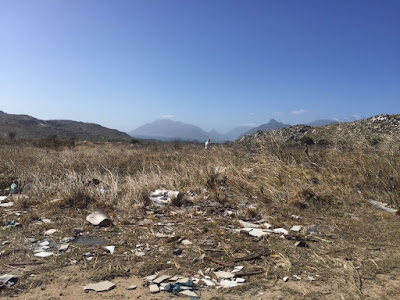Fatherland
The festival comprised of artists who live in the area and art was made in sites that would disrupt these boundaries.
Fatherland explores my relationship to the land I'm born in, the colonial legacy of privilege and political dividing and mapping of land.
The work sits with the matter of division of people, being stuck in a situation, commitment to a process [transformation]; stories, eliciting threads that run through existing structures and development of new stories.
Briefly: I was sitting on a concrete tube [found in the veld] with my feet buried in the soil. The site is a derelict apparently abandoned water reservoir, in the veld above Ocean View, with a spectacular view out towards the sea. I'm sitting, methodically making a continuous thread by meticulously tearing the pages of an atlas, and binding it into a large ball of yarn.
 I sat and made yarn for an hour and a half. I was self-contained, focusing and absorbed by the yarn making process. My posture although absorbed in the process of yarn making, is open and receptive to any encounter by viewer/ audience.
I sat and made yarn for an hour and a half. I was self-contained, focusing and absorbed by the yarn making process. My posture although absorbed in the process of yarn making, is open and receptive to any encounter by viewer/ audience.
Toward the very end, when the audience was about to move to the next location, a group of young adolescent girls, who had been watching me for some time, approached me and gently and respectfully asked what I was doing.
My reply was that I was not exactly sure, but perhaps together we could make sense of my activities. I pointed out a few details, and the following was revealed.
 Feet in the sand: stuck with this social/political geographical legacy of injustice which separates people from each other and the environment.
Feet in the sand: stuck with this social/political geographical legacy of injustice which separates people from each other and the environment.
Tearing up of the atlas disrupts the maps, brings disparate places and people together warmly (ball of yarn)
And in response to: “….hmmmmm seen you tear paper before...” passing remark from a friend: The work isn't entertaining, it’s boring. It requires some effort, requires a willingness to become quiet and engage with spaces between things.




Comments
Post a Comment